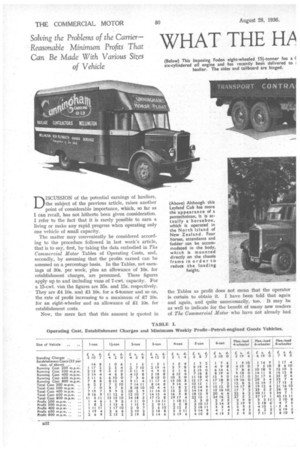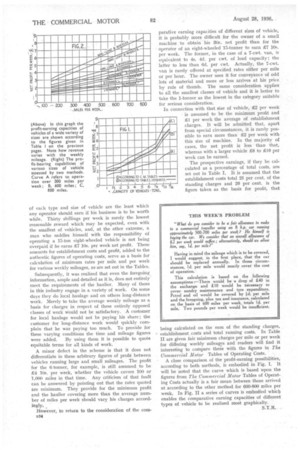WHAT THE HA JER CAN EARN
Page 42

Page 43

Page 44

If you've noticed an error in this article please click here to report it so we can fix it.
DISCUSSION of the potential earnings of hauliers, the subject of the previous article, raises another point of considerable importance, which, so far as I can recall, has not hitherto been given consideration. I refer to the fact that it is rarely possible to earn a living or make any rapid progress when operating only one vehicle of small capacity.
The matter may conveniently be considered according to the procedure followed in last week's article, that is to say, first, by taking the data embodied in The Commercial Motor Tables of Operating Costs, and, secondly, by assuming that the profits earned can be assessed on a percentage basis. In the Tables, net earnings of 30s. per week, plus an allowance of 10s. for establishment charges, are presumed. These figures apply up to and including vans of 7-cwt. capacity. For a 15-cwt. van the figures are 35s. and 15s. respectively. They are 21 10s. and 21 10s. for a 6-tonner and so on, the rate of profit increasing to a maximum of 27 10s. for an eight-wheeler and an allowance of £1 10s. for establishment costs.
Now, the mere fact that this amount is quoted in the Tables as profit does not mean that the operator is certain to obtain it. I have been told that again and again, and quite unnecessarily, too. It may be as well to indicate for the benefit of many new readers of The Commercial Motor who have not already had
the information, just what the figures do really mean.
It was realized many years ago that the outstanding difficulty of the small haulier was that of knowing what to charge for the hire of a vehicle, or for the conveyance of a load. Few appreciated that the rate per mile, for example, must, if it is to be profitable, vary inversely as the weekly mileage covered by the vehicle. If the weekly mileage be great, the cost and the profitable charge may be comparatively small and vice versa.
Obviously, before figures giving appropriate rates could be calculated, some assumptions had to be made as to what might be regarded as a reasonable profit. Moreover, it was necessary to impress inexperienced hauliers with the fact that there were expenses other than the operating costs of the vehicle to be met before the stage of making a profit was reached. The need for guidance on these matters appears to be hardly less to-day than it was when these Tables began to be published 28 years ago.
Assumptions were, therefore, made, first, for these extra expenses, which were given the orthodox name of establishment costs. The figures in the Tables for these Costs may not fit the circumstances of every haulier: they have, however, proved to be nearly right in the vast majority of cases, so near that they may be taken as correct in all but exceptional classes of haulage work.
The amounts quoted as reasonable profits in respect of each type and size of vehicle are the least which any operator should earn if his business is to be worth while. Thirty shillings per week is surely the lowest reasonable _reward which may be expected, even with the smallest of vehicles, and, at the other extreme, a man who saddles himself with the responsibility of operating a 15-ton eight-wheeled vehicle is not being overpaid if he earns £7 10s. per week net profit. These amounts for establishment costs and profit, added to the authentic figures of operating costs, serve as a basis for calculation of minimum rates per mile and per week for various weekly mileages, as are set out in the Tables.
• Subsequently, it was realized that even the foregoing information, ample and detailed as it is, does not entirely' meet the requirements of the haulier. Many of those in this industry engage in a variety of work. On some days they do local haulage and on others long-distance work. Merely to take the average weekly mileage as a basis for charges in respect of these entirely opposed classes of work would not be satisfactory. A customer for local haulage would not be paying his share; the customer for long-distance work would quickly complain that he was paying too much. To provide for these varying conditions the time and mileage figures were added. By using them it is possible to quote equitable terms for all kinds of work.
A minor defect in the scheme is that it does not differentiate in these arbitrary figures of profit between vehicles running large and small mileages. The profit for the 6-tonner, for example, is still assumed to be £4 10s. per week, whether the vehicle covers 100 or 1,000 miles in that time. Any criticism of that fault can be answered by pointing out that the rates quoted are minimum. They provide for the minimum profit and the haulier covering more than the average number of miles per week should vary his charges accordingly..
However, to return to the consideration of the corne34 parative earning capacities of different sizes of vehicle, it is probably more difficult for the owner of a small machine to obtain his 30s. net profit than for the operator of an eight-wheeled 15-tonner to earn £7 10s. per week. The former, in the case of a 7-cwt. van, is equivalent to 4s. 4d. per cwt. of load capacity: the latter to less than 6d. per cwt. Actually, the 7-cwt. van is rarely offered at specified rates either per mile or per hour. The owner uses it for conveyance of odd lots of material and more or less arrives at his price by rule of thumb. The same consideration applies to all the smallest classes of vehicle and it is better to take the 1-tanner as the lowest in the category suitable for serious consideration.
In connection with that size of vehicle, £2 per week is assumed to be the minimum profit and Al per week the average of establishment charges. It will be admitted that, apart from special circumstances, it is rarely possible to earn more than E2 per week with this size of machine. In the majority of cases, the net profit is less than that, whereas with a larger vehicle £8 to £10 per week can be earned. (c The prospective earnings, if they be calculated as a percentage of total costs, are set out in Table I. It is assumed that the establishment costs total 25 per cent, of the standing charges and 20 per cent, is the figure taken as the basis for profit, that
being calculated on the sum of the standing charges, establishment costs and total running costs. In Table II are given fair minimum charges per mile or per week for differing weekly mileages and readers will find it interesting to compare these with the figures in The Commercial Motor Tables of Operating Costs.
A close comparison of the profit-earning possibilities, according to both methods, is embodied in Fig. I. It will be noted that the curve which is based upon the figures from The Commercial Motor Tables of Operating Costs actually is a fair mean between those arrived at according to the other method for 600-800 miles per week. In Fig. II a series of curves is embodied whicl} enables the comparative earning capacities of different types of vehicle to be realized most graphically.
S.T.R.




















































































